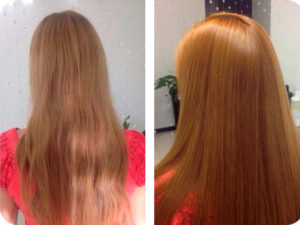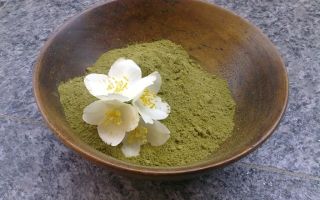Content
- 1 What is henna made of?
- 2 Henna types
- 3 Useful properties of henna
- 4 Why is henna better than hair dye
- 5 Can pregnant and lactating women dye their hair with henna
- 6 How to cook henna properly
- 7 What determines hair color after dyeing with henna
- 8 How to apply henna to hair
- 9 How long to keep henna
- 10 How to properly wash off henna from hair
- 11 Features of hair coloring with henna and basma
- 12 Henna harm to hair and contraindications for use
- 13 How to reduce the harmful effects of henna on hair
- 14 How to choose henna for hair
- 15 Conclusion
- 16 Reviews
Henna is one of the most ancient hair dyes that remains in demand to this day. However, some connoisseurs of natural beauty products are wary of this pigment. The question remains why it has earned a controversial reputation and what the benefits and harms of henna for hair actually are.
What is henna made of?
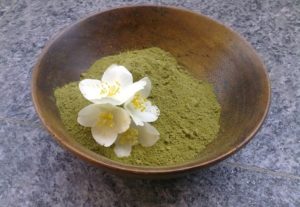
A popular natural color is a loose powder made from dried leaves of a shrub called thornless lawsonia. For hair dyeing, as a rule, the lower leaves of the plant are used, which are subjected to a rougher processing. The foliage from the upper branches is most often used for applying wearable designs, which are called mehendi.
A distinctive property of this dye is the ability to give hair a rich red or copper-brown color, depending on the natural shade of the hair. Nevertheless, today, manufacturers of natural dyes are finding new ways to diversify the color palette and chemical composition of henna in order to enhance its benefits for hair and make it even more attractive to consumers.
However, even without these additions, henna has a lot of useful properties that distinguish it favorably from other means for changing hair pigment.
Henna types
There are several types of henna for hair:
- ordinary, or red;
- colorless;
- black henna, or basma.
Henna in the traditional sense is made from lavsonia, while basma is obtained from indigo dye leaves.
Colorless henna is an extract of the same lawsonia, which is processed in such a way that all pigment is removed from it, so this substance has almost no effect on hair color. However, its beneficial properties will be appreciated by those who wish to prolong the health and beauty of their hair.
Useful properties of henna
Lawsonia powder has proven its worth for thousands of years. It has been used in India, Pakistan, and North African countries to treat a variety of skin conditions, including dandruff, boils, and acne. With its help, stomatitis and trophic ulcers were eliminated. The bactericidal properties of the dye relieved edema and inflammation.
But the healing properties of henna are most beneficial for the condition of the hair. In addition to providing long-lasting color, this unique natural paint also:
- has a beneficial effect on the scalp;
- helps to strengthen hair follicles, preventing hair loss;
- has a useful property to regulate the production of sebum, thanks to tannins in its composition;
- restores the structure of the hair shaft, preventing it from exfoliating;
- gives curls shine, makes them more obedient.
Why henna is better than hair dye
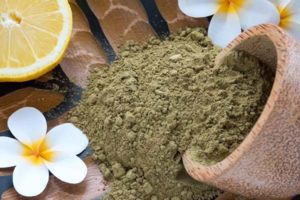
Despite a number of useful properties of lawsonia powder, many lovers of experimenting with hairstyle prefer artificially created hair dyes, as they are discouraged by the unpredictability of the result when working with henna. However, the latter has a number of advantages that chemical-based hair dyes cannot boast of:
- Principle of operation... Henna, unlike its unnatural counterparts, has a more gentle effect on the hair, enveloping only the outer layer of the hair shaft and not disturbing the hair structure. Chemical dyes penetrate the hair, completely destroying its natural pigment. Therefore, even gentle dyes with prolonged use have a harmful effect, making the hair weaker and more brittle.
- No harmful effect on human well-being... Henna powder does not cause allergic reactions and does not harm the body, and therefore can be used by people in any state of health.
- Anti-inflammatory properties... Natural dye not only heals the hair, but also takes care of the scalp.
- Multitasking... Henna can not only change the color of curls, but is also suitable for eyelashes, eyebrows and body painting.
- Price... In addition to its obvious benefits, the pigment is attractive for its low cost, especially in comparison with artificial alternatives for dyeing hair, which can be quite expensive.
Can pregnant and lactating women dye their hair with henna
Another significant difference between henna for hair and other dyes lies in the fact that it is absolutely safe for nursing mothers and pregnant women. Henna, like basma, is a natural plant pigment, the benefits and absence of a toxic odor of which make it possible to use it during pregnancy and breastfeeding without fear of harming oneself or the baby.
Nevertheless, it should be borne in mind that due to fluctuations in the hormonal background in the first trimester of pregnancy, hair coloring with henna and basma can lead to unexpected results in terms of color, which is often far from the desired one. Therefore, it is a wise decision not to carry out the staining procedure for the first 11 to 12 weeks.
How to cook henna properly
However, in order to extract the maximum benefit from the plant dye for hair and get a bright shade, you need to be able to properly prepare the mixture for coloring:
- It is necessary to strictly follow the instructions on the henna packaging, since the slightest deviation from the instructions can have a significant impact on the result.
- You should not dilute lawsonia powder in boiling water, since too high a temperature negates all the useful properties. The ideal water temperature should be 70 oFROM.
- It is advisable to dilute the coloring composition of henna in a ceramic, clay or glass vessel. Any other dishware, upon contact with the dye, triggers an oxidative process, the harm of which can affect the final shade of the hair.
- Since paint tends to deteriorate quickly in an open package, it is worth using the entire available portion of the powder if possible.
What determines hair color after dyeing with henna
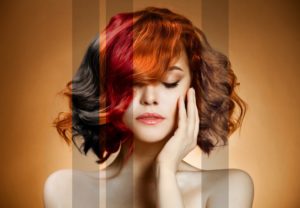
Henna powder, due to its beneficial properties, has a fairly wide range of various shades. This variation is primarily due to the natural hair color that will be dyed. So, light-colored curls will acquire a bright red color with a golden tint, and light brown and dark ones will be equal in color to copper or will become a mahogany shade. But this is provided that they have not previously come into contact with chemical paint, otherwise later the reflection in the mirror will surprise you with bright blue or green strands.But basma gives hair a deep chocolate or black color, depending on the amount of substance.
In addition, you can slightly diversify the above palette by combining henna and basma with each other or mixing them with other natural pigments. This will enrich the dye mixture with additional useful compounds:
- Lawsonia powder and coffee will give the curls a dark red or chestnut tone;
- together with beet juice, it will give an eggplant or purple hue;
- vegetable pigment drenched in milk will make the red color several times darker;
- Basma in combination with red henna will help achieve a fresh cinnamon hue.
How to apply henna to hair
Paint application also has its own nuances. To avoid the harm of unexpected reactions during the procedure, you should prepare in advance for it:
- It is advisable to carry out staining on pre-washed dry strands. It is worth drying curls naturally without using a hair dryer.
- Before painting, it will be useful to cover your shoulders and neck with an oilcloth cape.
- The area around the forehead and ears should be generously lubricated with a fat cream so that at the end of the procedure no traces of the dye remain on them.
- It is necessary to carry out coloring in rubber gloves, since the substance tends to be absorbed into the skin for a long time.
The staining itself is carried out according to the following scheme:
- The dye is applied to the roots, moving from the occiput to the forehead.
- Then the mixture is evenly distributed along the entire length, trying not to hesitate so that the product does not cool too much.
- After that, the head is wrapped in polyethylene. For these purposes, you can use a cellophane bag.
- From above, insulate the head with a soft piece of fabric, for example, an old towel.
How long to keep henna
The optimal duration of the dye depends on many factors, including the initial tone of the curls, their length, skin type, type of dye, its properties and quantity. The most accurate time indicators, as a rule, are displayed in the instructions, which you need to focus on in the first place. After all, if you keep the composition on your hair for too long, you can cause significant harm to them. If the dye is washed off ahead of time, the entire effect of the procedure can be completely reduced to zero.
The average exposure time for natural blondes is only 10-15 minutes. Owners of fair-haired braids will need 30 - 60 minutes; brown-haired women will have to wait from 2 to 3 hours, depending on the length.
How to properly wash off henna from hair
Lawsonia powder is notable for its durability, and therefore it can be difficult to wash it off after staining is complete. At this stage of the procedure, there are some peculiarities:
- To get rid of the paint, the curls are washed with running water until the liquid becomes completely transparent. For efficiency, the curls are divided into strands and washed one by one.
- When flushing, do not use shampoo and soap.
- Conditioner is applied to the strands if desired.
- For the next three days, they do not wash their hair so that the color is fixed.
Features of hair coloring with henna and basma
A few useful tips will help you dye without problems and get the desired hair color:
- Be careful when applying Lawsonia powder to gray hair. At best, the paint will not be able to gain a foothold, and at worst it will make curls of a ripe tangerine shade.
- Pure henna and basma are perfect for normal and oily hair, while dry curls are undesirable to handle. To mitigate the effect, it is worth combining dyes with any vegetable oil - there will be less harm from pigments, and the beneficial substances of the oils will enrich the strands with minerals and vitamins.
- Do not worry if immediately after coloring the color becomes overly saturated. After a few days, the shade will become more natural.
Henna harm to hair and contraindications for use
The uniqueness of Lavsonia powder, in addition to a large number of useful properties, lies in the almost complete absence of any harm to humans. It does not cause allergic reactions and other discomfort, which is why almost everyone can use it. The only medical contraindication is glucose-6-phosphate dehydrogenase deficiency, a rare congenital metabolic anomaly common mainly in Africa, Asia and the Middle East.
However, with all its advantages, henna also has some disadvantages, which, although they are purely cosmetic in nature, can have a significant impact on the appearance of the strands. So, it is not recommended for already colored curls, as it can change the original shade beyond recognition. The same applies to the opposite situation: hair that has been exposed to lawsonia powder cannot be dyed with chemical agents, otherwise you can become the owner of not very attractive green hair. Then, it will not work to correct the consequences of unsuccessful henna painting with the help of paints of famous brands. In this case, you will have to wait until the strands grow back completely.
In addition, the powder is absolutely incompatible with a perm, as it has the property of straightening artificially curled curls.
Another property of the powder is difficult to wash off the skin, it brings not so much harm as inconvenience. Therefore, in the process of staining, double care must be taken so as not to get your face and hands dirty.
And although short-term use of tinted henna is only beneficial to hair, long-term use of it can cause significant harm. So, the abuse of the coloring matter violates the integrity of the protective layer of the strands, because of which they become hard, dull, split, and have lost elasticity. For this reason, before use, you should carefully read the instructions and strictly follow them.
How to reduce the harmful effects of henna on hair
You can significantly reduce the harmful effects of paint if you follow simple recommendations.
- Do not use Lawsonia powder more than once every 3 to 4 weeks.
- It is strongly not recommended to mix a chemical dye with a natural one.
- For maximum benefit when dyeing your hair with henna, follow the instructions.
- Colorless henna masks should not be done too often. To avoid harmful effects, it is enough to carry out the procedure once a week.
How to choose henna for hair
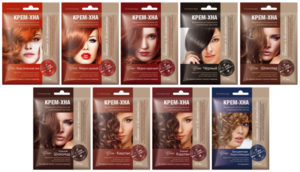
Choosing a dye is not an easy task. To reduce possible harm to zero and extract only benefit from the product, it is recommended:
- Monitor the expiration date of the product.
- Give preference to a dye made from natural ingredients without artificial additives.
- Choose paint in undamaged packaging.
- Decide in advance for what purpose the product will be used. For dyeing, it is worth stopping the choice on basma and red henna, and colorless is better for masks and health products.
- Pay attention to the country of origin. Iranian, Turkish and Indian henna is considered the highest quality and natural.
Conclusion
Although the benefits and harms of henna cause a lot of controversy among cosmetologists, doctors and ordinary people, in medical terms, you can not be afraid of the harmful effects of this pigment. On the contrary, it has significant cosmetic value due to its beneficial properties for the skin and hair. Therefore, with the right approach, Lawsonia powder can not only emphasize the beauty of the curls, but also preserve their health for a long time.
Reviews
